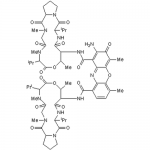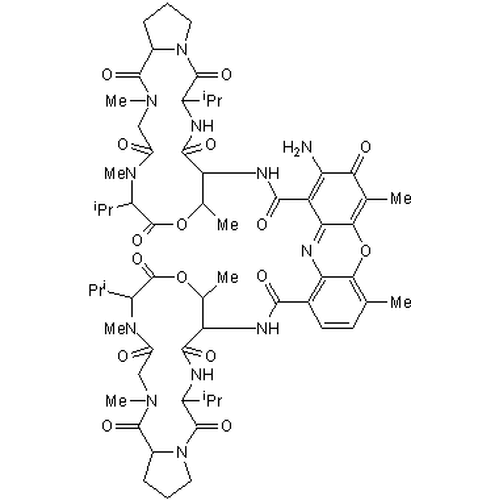| Product Name | Actinomycin D |
| Description |
Transcription inhibitor |
| Purity | >98% |
| CAS No. | 50-76-0 |
| Molecular Formula | C62H86N12O16 |
| Molecular Weight | 1255.43 |
| Field of Use | Not for use in humans. Not for use in diagnostics or therapeutics. For in vitro research use only. |
Properties
| Storage Temperature | -20ºC |
| Shipping Temperature | Shipped Ambient |
| Product Type | Inhibitor |
| Solubility | Soluble to 50 mM in DMSO |
| Source | Synthetic |
| Appearance | White Solid |
| SMILES | CC1C(C(=O)NC(C(=O)N2CCCC2C(=O)N(CC(=O)N(C(C(=O)O1)C(C)C)C)C)C(C)C)NC(=O)C3=C4C(=C(C=C3)C)OC5=C(C(=O)C(=C(C5=N4)C(=O)NC6C(OC(=O)C(N(C(=O)CN(C(=O)C7CCCN7C(=O)C(NC6=O)C(C)C)C)C)C(C)C)C)N)C |
| InChI | InChI=1S/C62H86N12O16/c1-27(2)42-59(84)73-23-17-19-36(73)57(82)69(13)25-38(75)71(15)48(29(5)6)61(86)88-33(11)44(55(80)65-42)67-53(78)3 |
| InChIKey | RJURFGZVJUQBHK-UHFFFAOYSA-N |
| Safety Phrases |
Classification: Very Toxic. May be fatal if inhaled, swallowed or absorbed through skin. Safety Phrases: S22 - Do not breathe dust S24/25 - Avoid contact with skin and eyes S36/37/39 - Wear suitable protective clothing, gloves and eye/face protection S45 - In case of accident or if you feel unwell, seek medical advice immediately (show the label where possible) Risk Phrases: R26/27/28 - Very Toxic by inhalation, in contact with skin and if swallowed R36/37/38 - Irritating to eyes, respiratory system and skin R40 - Limited evidence of a carcinogenic effect R62 - Possible risk of impaired fertility Hazard Phrases: H300 – Fatal if swallowed Precautionary Phrases: P264 –P301 + P310 |
| Cite This Product | Actinomycin D (StressMarq Biosciences, Canada, Cat # SIH-245) |
Biological Description
| Alternative Names | 2-Amino-N,N'-bis(6,13-diisopropyl-2,5,9-trimethyl-1,4,7,11,14-pentaoxohexadecahydro-1H-pyrrolo[2,1-i][1,4,7,10,13]oxatetraazacyclohexadecin-10-yl)-4,6-dimethyl-3-oxo-3H-phenoxazine-1,9-dicarboxamide |
| Research Areas | Apoptosis, Cancer |
| PubChem ID | 2019 |
| Scientific Background | The actinomycins are a class of polypeptide antibiotics. Actinomycin D inhibits transcription by binding DNA at the transcription initiation complex and preventing elongation by RNA polymerase (1). Actinomycin D has been used as a chemotherapy drug (2), and an antibiotic. |
| References |
1. Sobell H. (1985) Proc Natl Acad Sci USA. 82(16): 5328-31. 2. Turan T., et al. (2006) Int J Gynecol Cancer. 16(3): 1432-1438. |



Reviews
There are no reviews yet.